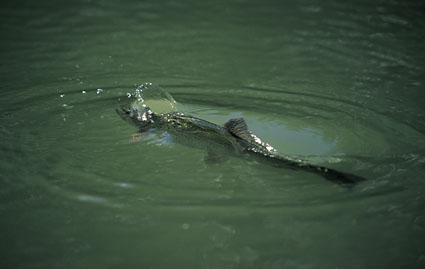Michael,
When the fish are rising and you don't see a hatch, rather than fish a wet fly, this is an opportunity to figure out what they are eating. You need a strategy for this type of situation.
First - I noticed that you never described a rise. Not all rises are equal. Examine the type and location of the rises.
You need to study the "rise form." Just as a fly fisher "reads the water" for the potential holding areas of trout, you "read the rise" for the location of the food that the fish ate.
There are three locations at which fish take flies during emergence - UNDER, IN, or ON the surface film. You need to determine whether the fish took the insect under film, in the film, or on top of the film.
If you look very carefully, you can tell how the fish took the aquatic insect, and where the insect was in the water column.
Here is an illustration from Field and Stream that shows:
1. A sipping rise to an insect trapped in or on the film, fine rings in the water = emerger, stillborn emerger, spinner, some small midges.
2. The slurping rise leaves a bubble, the fish's mouth breaks the surface to take a fully emerged insect = mayfly duns and other insects that have fully hatched.
3. The splashy rise, the fish slashes at the fly = typically a rise to caddis that can fly off immediately or a large terrestrial on the water like a grasshopper. The fish want the insect not to escape OR wants to beat another fish to the food.
4. The boil or head and shoulder rise. The water bulges but the fish's mouth does not break the water. The fish's shoulder or dorsal fin may break the water as the fish heads back down = The fish is feeding below the surface chasing nymphs or pupa that are rising in the water column to hatch. They are intercepting the food on the way to the surface and overshoot and break the surface or cause a bulge of water.
If you spend some time carefully looking at "rising" fish, you will notice that during a hatch, there can be different rise forms. Not all the fish will necessarily be feeing on the same stage of insect.
This is why some fly fishers will put on a specific fly and catch some of the rising fish, but then that fly stops "working" and they wonder why. It is because that fly imitated a certain stage of emergence and caught the fish that were taking that stage but it does not imitate the star that the other fish are feeding on.
Identify the rise forms and then from the rise forms, decide what stage of the insect the fish is feeding on.
Second - Then examine the location of the rises - For example a sipping rise in the back eddies could be the fish are eating spinner. Rises near the shore could be to terrestrials like ants or beetles.
You get the idea. From the rise form and the location of the rises you decide what fly you need to use and where to use it.
Third - Then there using a bug net to sample the drift. You could done this to find what was in the drift and choose the appropriate fly and fish that fly at the appropriate level with the appropropriate technique.
https://www.theflyfishingforum.com/...on/803759-trout-ungrateful-2.html#post1421058
Fourth - You lost an opportunity to learn. Since you did catch a fish, that would have been a perfect opportunity use a throat pump to sample what that fish had fed on.
fishing emergers
There are plenty of other options than committing to wet flies when you see fish rising and can't catch the risers. I think this is situation is a perfect opportunity to learn what is really happening.







.jpg)
.jpg)
